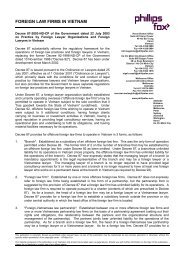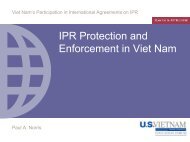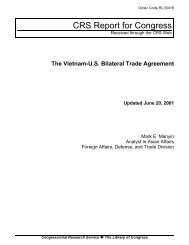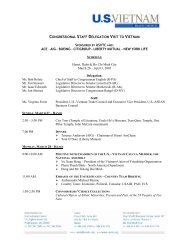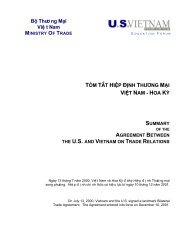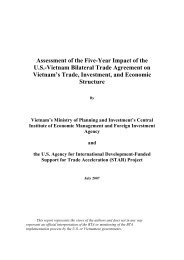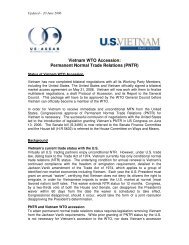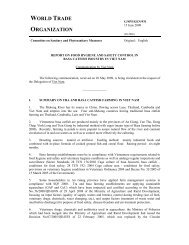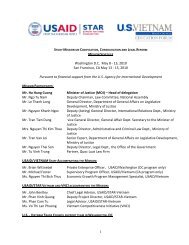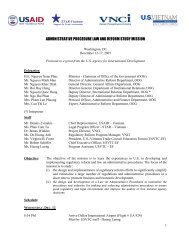Climate risks and adaptation in Asian coastal megacities: A synthesis
Climate risks and adaptation in Asian coastal megacities: A synthesis
Climate risks and adaptation in Asian coastal megacities: A synthesis
- No tags were found...
You also want an ePaper? Increase the reach of your titles
YUMPU automatically turns print PDFs into web optimized ePapers that Google loves.
RecommendationsCoastal cities <strong>in</strong> develop<strong>in</strong>g countries face enormouschallenges l<strong>in</strong>ked with current patternsof population <strong>and</strong> economic growth, associatedenvironmental externalities, urban expansion <strong>and</strong>exist<strong>in</strong>g climate variability. <strong>Climate</strong> change willpose additional <strong>risks</strong> beyond those currently fac<strong>in</strong>g<strong>coastal</strong> <strong>megacities</strong>. As the study shows, these <strong>risks</strong>will also be associated with significant costs to localpopulations <strong>and</strong> <strong>in</strong>frastructure. Strong political willis thus needed to strengthen the capacity to addressboth exist<strong>in</strong>g climate variability <strong>and</strong> additional <strong>risks</strong>posed by climate change. Three ma<strong>in</strong> lessons st<strong>and</strong>out from the study.Better management of urban environment<strong>and</strong> <strong>in</strong>frastructure will help manage potentialclimate-related impactsAnalysis carried out <strong>in</strong> the city case studies showthat sound urban environmental management isalso good for climate <strong>adaptation</strong>. As the Bangkokstudy shows, l<strong>and</strong> subsidence, if not arrested, wouldcontribute a greater share of damage costs fromfloods than a projected change <strong>in</strong> climate conditions.Thus, address<strong>in</strong>g l<strong>and</strong> subsidence <strong>and</strong> factors contribut<strong>in</strong>gto it is important from the perspective ofurban <strong>adaptation</strong>. While the HCMC study has notestimated the damage costs due to other environment-developmentfactors—such as the presence ofsolid waste <strong>in</strong> the city’s dra<strong>in</strong>s <strong>and</strong> waterways, poordredg<strong>in</strong>g of canals, siltation of dra<strong>in</strong>s, deforestation<strong>in</strong> the upper watershed—it provides extensivequalitative evidence to demonstrate the role thesefactors play <strong>in</strong> contribut<strong>in</strong>g to urban flood<strong>in</strong>g.Collectively, the studies highlight the importanceof address<strong>in</strong>g exist<strong>in</strong>g environment-developmentfactors as a critical part of urban <strong>adaptation</strong>. Theyalso show that given the high <strong>risks</strong> of cont<strong>in</strong>u<strong>in</strong>gto urbanize accord<strong>in</strong>g to current patterns, muchmore effort should be given to consider<strong>in</strong>g theenvironmental implications of urban growth <strong>and</strong>expansion <strong>in</strong> the context of manag<strong>in</strong>g current <strong>and</strong>future climate <strong>risks</strong>.<strong>Climate</strong>-related <strong>risks</strong> should be considered asan <strong>in</strong>tegral part of city <strong>and</strong> regional plann<strong>in</strong>gWhile improved urban environmental managementis important, the studies also show that given theadditional costs l<strong>in</strong>ked with climate change, citiesneed to make a proactive effort to consider climaterelated<strong>risks</strong> as an <strong>in</strong>tegral part of urban plann<strong>in</strong>g<strong>and</strong> to do so now. First, city planners need to developstrategic urban <strong>adaptation</strong> frameworks formanag<strong>in</strong>g climate <strong>risks</strong> <strong>in</strong>volv<strong>in</strong>g a range of toolssuch as policy <strong>and</strong> regulatory reforms, <strong>in</strong>vestments,<strong>and</strong> capacity build<strong>in</strong>g. Such a strategy can providean overarch<strong>in</strong>g framework for actions taken with<strong>in</strong>each sector at the regional, delta, <strong>and</strong> city levels.Second, much more emphasis needs to be given toimprov<strong>in</strong>g the knowledge base regard<strong>in</strong>g climate<strong>risks</strong> <strong>and</strong> related socioeconomic <strong>and</strong> developmentfactors. Develop<strong>in</strong>g <strong>and</strong> updat<strong>in</strong>g scenarios <strong>and</strong>plann<strong>in</strong>g for a range of potential outcomes will becritical for urban planners. This can be accomplishedby strengthen<strong>in</strong>g the collaboration between plann<strong>in</strong>g<strong>and</strong> sector agencies <strong>and</strong> research <strong>in</strong>stitutions,thus giv<strong>in</strong>g municipal agencies the tools to makedecisions regard<strong>in</strong>g risk management over the longterm (Rosenzweig et al. 2007) Third, it is importantto strengthen the capacity of local urban governmental<strong>in</strong>stitutions to adapt to climate change.Among other th<strong>in</strong>gs, this <strong>in</strong>volves strengthen<strong>in</strong>g thecapacity to prioritize different <strong>adaptation</strong> options,improv<strong>in</strong>g coord<strong>in</strong>ation between various urbansector agencies <strong>and</strong> sector plans, <strong>and</strong> <strong>in</strong>corporat<strong>in</strong>gclimate change considerations <strong>in</strong>to the earlieststages of decision mak<strong>in</strong>g.Targeted, city-specific solutions comb<strong>in</strong><strong>in</strong>g<strong>in</strong>frastructure <strong>in</strong>vestments, zon<strong>in</strong>g, <strong>and</strong>ecosystem-based strategies are requiredGiven that cities are characterized by dist<strong>in</strong>ct climatic,hydrological, <strong>and</strong> socioeconomic features—but also that the urban poor <strong>in</strong> general are morevulnerable to <strong>in</strong>creased flood<strong>in</strong>g due to climatechange—targeted, city-specific, <strong>and</strong> cutt<strong>in</strong>g edgeapproaches to urban <strong>adaptation</strong> are needed. First,xvi | <strong>Climate</strong> Risks <strong>and</strong> Adaptation <strong>in</strong> <strong>Asian</strong> Coastal Megacities: A Synthesis Report



